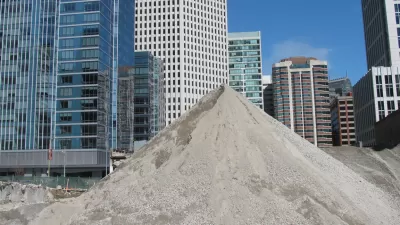The news keeps getting worse at San Francisco's newly opened, since closed, Salesforce Transit Center.

After barely more than a month of operation, the $2.2 billion Salesforce Transit Center was closed in September after inspectors discovered cracks in two of the building's four steel support beams.
Since then, the legal and political drama has taken hold.
"San Francisco city officials are withholding $9.6 million meant to fund expansion planning for the Salesforce Transit Center, in a bid to hold its leadership accountable for alleged mismanagement of the $2.2 billion project," reported Joe Fitzgerald Rodriguez on October 18.
"That funding was aimed toward design and engineering of a planned future phase of the transit center, in which the basement floor will be converted to accommodate California High Speed Rail and a soon-to-be electrified Caltrain," adds Fitzgerald Rodriguez. (There's more on the threat to future planning efforts later in this article).
News of the city's reluctance to continue funding the project came a day after news of a lawsuit, reported by Rachel Swan, over mismanagement of the project. That lawsuit doesn't even mention the cracked beams. Swan explains:
The suit covers the $2.2 billion center’s construction phase and makes no mention of the current problems facing the facility....But the action is the latest in a series of lawsuits stemming from the project’s delays and cost overruns, and it blames the authority for “mismanagement, failures, and delays.”
Fast forward to this week, when the San Francisco County Transportation Authority Board voted to finalize the decision to suspend funding for next planning steps for the project "until The City can evaluate what led to the discovery last month of cracks in two steel beams, shutting down the newly constructed $2.2 billion transit center," according to the most recent article on the subject from Fitzgerald Rodriguez.
From another article by Rachel Swan comes more bad news that testing of the cracked steel beams has been delayed—results are now expected back in mid-November. "Only then can officials determine what happened and how to fix it, said Mark Zabaneh, executive director of the Joint Powers Authority, speaking to the authority Tuesday. A reopening date has not been set," according to Swan.
FULL STORY: City withholds Salesforce Transit Center funding as allegations of mismanagement mount

Alabama: Trump Terminates Settlements for Black Communities Harmed By Raw Sewage
Trump deemed the landmark civil rights agreement “illegal DEI and environmental justice policy.”

Planetizen Federal Action Tracker
A weekly monitor of how Trump’s orders and actions are impacting planners and planning in America.

The 120 Year Old Tiny Home Villages That Sheltered San Francisco’s Earthquake Refugees
More than a century ago, San Francisco mobilized to house thousands of residents displaced by the 1906 earthquake. Could their strategy offer a model for the present?

In Both Crashes and Crime, Public Transportation is Far Safer than Driving
Contrary to popular assumptions, public transportation has far lower crash and crime rates than automobile travel. For safer communities, improve and encourage transit travel.

Report: Zoning Reforms Should Complement Nashville’s Ambitious Transit Plan
Without reform, restrictive zoning codes will limit the impact of the city’s planned transit expansion and could exclude some of the residents who depend on transit the most.

Judge Orders Release of Frozen IRA, IIJA Funding
The decision is a victory for environmental groups who charged that freezing funds for critical infrastructure and disaster response programs caused “real and irreparable harm” to communities.
Urban Design for Planners 1: Software Tools
This six-course series explores essential urban design concepts using open source software and equips planners with the tools they need to participate fully in the urban design process.
Planning for Universal Design
Learn the tools for implementing Universal Design in planning regulations.
Clanton & Associates, Inc.
Jessamine County Fiscal Court
Institute for Housing and Urban Development Studies (IHS)
City of Grandview
Harvard GSD Executive Education
Toledo-Lucas County Plan Commissions
Salt Lake City
NYU Wagner Graduate School of Public Service





























